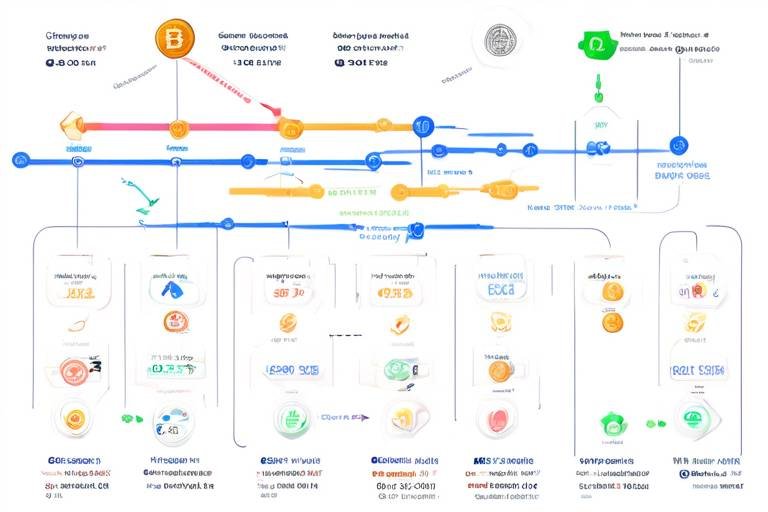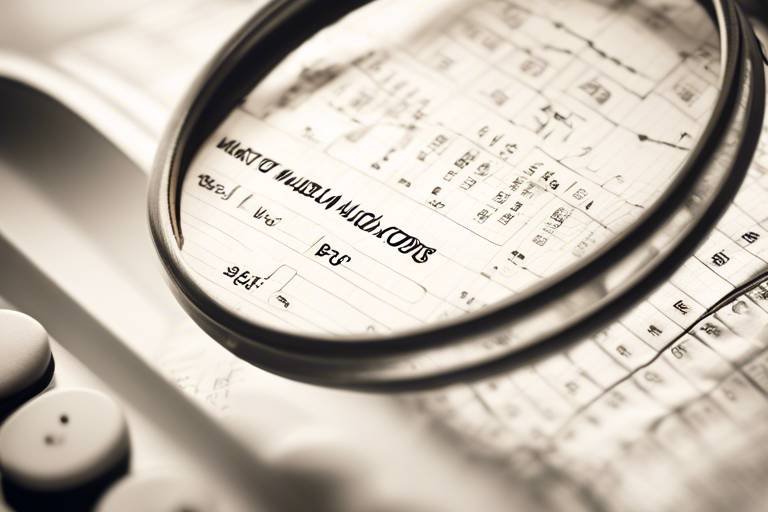The Importance of Continuous Learning in Technical Trading
In the fast-paced world of financial markets, the only constant is change. As a trader, you may find yourself navigating through a sea of information, strategies, and market dynamics that evolve daily. This is where continuous learning becomes not just beneficial, but absolutely essential. It’s like being on a rollercoaster; if you don’t keep your hands and mind engaged, you might just miss the thrill of the ride—or worse, get thrown off course.
Imagine stepping into a trading arena where the rules are constantly shifting. Economic reports, technological advancements, and shifts in investor sentiment can all impact market behavior. To thrive in this environment, traders must become lifelong learners, constantly updating their knowledge and skills. This commitment to learning allows traders to adapt their strategies and seize opportunities that others may overlook. Think of it as upgrading your toolkit; without the right tools, even the most skilled craftsman would struggle to build something great.
Moreover, continuous learning fosters confidence in your trading decisions. When you understand the nuances of technical analysis, market psychology, and risk management, you’re not just reacting to market movements—you’re anticipating them. This proactive approach can lead to better financial outcomes, as you become adept at reading the market’s signals. With every new concept you grasp, you build a stronger foundation for your trading career, akin to laying bricks in a sturdy wall that can withstand the storms of market volatility.
So, how can traders effectively engage in continuous learning? Here are a few strategies:
- Reading and Research: Dive into books, articles, and research papers that cover various aspects of technical trading.
- Online Courses: Enroll in courses that offer in-depth knowledge on specific trading strategies or tools.
- Webinars and Seminars: Attend live sessions where experts share their insights and experiences.
- Networking: Join trading communities or forums to exchange ideas and learn from fellow traders.
In conclusion, the journey of a trader is one of perpetual learning. By embracing this mindset, you not only enhance your skills but also position yourself as a resilient player in the financial markets. Remember, the more you learn, the more you earn. So buckle up, keep your mind open, and enjoy the ride!
Q1: Why is continuous learning important in technical trading?
A1: Continuous learning is crucial because financial markets are constantly changing. By keeping your knowledge up-to-date, you can adapt your strategies to new market conditions, improving your chances of success.
Q2: What are some effective ways to continue learning as a trader?
A2: Traders can enhance their knowledge through reading books, taking online courses, attending webinars, and engaging with trading communities for shared insights.
Q3: How does psychological resilience relate to continuous learning?
A3: Psychological resilience helps traders manage emotions and stress, which is vital for making rational decisions. Continuous learning builds confidence, enabling traders to face market challenges with a stronger mindset.

The Evolving Nature of Financial Markets
Financial markets are a dynamic and ever-changing landscape, influenced by a myriad of factors that can shift overnight. Imagine trying to catch a wave while surfing; just when you think you've got the rhythm down, the tide changes, and you have to adapt quickly. This is the reality for traders navigating the complex world of stocks, forex, and commodities. In today's fast-paced environment, understanding these changes is not just beneficial—it's essential for survival.
The evolution of financial markets can be attributed to several key elements:
- Economic Factors: Economic indicators such as GDP growth, unemployment rates, and inflation can dramatically impact market performance. Traders need to stay informed about these metrics to make educated decisions.
- Technological Advancements: The rise of high-frequency trading and algorithmic strategies has transformed how trades are executed, making it crucial for traders to understand these technologies and adapt their strategies accordingly.
- Investor Behavior: Market sentiment can shift based on news, social media, and even global events. Understanding the psychology behind these movements helps traders anticipate market trends.
Furthermore, the globalization of markets means that events in one part of the world can have ripple effects across the globe. For instance, a political upheaval in one country might lead to a sell-off in various international markets. This interconnectedness requires traders to be vigilant and informed about global events and trends.
Moreover, the rise of retail trading platforms has democratized access to financial markets, allowing more individuals to participate. This influx of new traders can lead to increased volatility, making it even more important for seasoned traders to continuously learn and adapt their strategies. As the saying goes, “what got you here won’t get you there.” In other words, past successes do not guarantee future results in such a fluid environment.
In conclusion, the evolving nature of financial markets necessitates a commitment to continuous learning. Traders must embrace change, stay informed about economic indicators, technological innovations, and shifts in investor behavior. By doing so, they can enhance their trading strategies and improve their chances of achieving favorable financial outcomes.

When diving into the world of technical trading, it's crucial to grasp some key concepts that serve as the foundation for successful trading strategies. Think of these concepts as the building blocks that allow traders to navigate the often turbulent waters of financial markets. Without a solid understanding of these principles, one might as well be sailing a ship without a compass. So, what are these essential elements that every trader should know?
First and foremost, chart patterns play a significant role in technical analysis. These patterns are like the fingerprints of market behavior, revealing trends and potential reversals. For instance, the head and shoulders pattern often indicates a shift from bullish to bearish sentiment, while a double bottom can signal a reversal from downtrend to uptrend. By recognizing these patterns, traders can make more informed decisions about when to enter or exit a trade.
Next up are indicators, which act as tools to help traders analyze market trends. Popular indicators like moving averages and the Relative Strength Index (RSI) can provide valuable insights into market momentum and potential price movements. Moving averages smooth out price data to identify the direction of the trend, while RSI measures the speed and change of price movements to assess whether an asset is overbought or oversold. Utilizing these indicators can enhance a trader's ability to make strategic decisions.
Another crucial aspect of technical trading is understanding market psychology. The market is driven not just by numbers but by the emotions and behaviors of its participants. Recognizing how fear and greed influence market movements can give traders an edge. For example, during periods of high volatility, traders might panic and sell off their assets, creating opportunities for others who can remain calm and rational. This psychological resilience is essential for long-term success in trading.
Moreover, traders should be familiar with support and resistance levels. These levels act as psychological barriers where the price tends to bounce off or reverse direction. Support is where buying interest overcomes selling pressure, while resistance is the opposite. By identifying these levels on a chart, traders can better predict potential entry and exit points, enhancing their trading strategies. Drawing trend lines can help visualize these levels and make informed decisions.
Lastly, it's important to recognize that continuous learning is vital in technical trading. Financial markets are ever-evolving, influenced by economic changes, technological advancements, and shifts in investor behavior. Staying updated with the latest trends, tools, and strategies is crucial for maintaining a competitive edge. Engaging in webinars, reading market analysis, and participating in trading communities can significantly enhance one's understanding and effectiveness in trading.
- What are chart patterns in technical trading?
Chart patterns are formations created by the movement of prices on a chart, indicating potential future price movements. - How do I use indicators in trading?
Indicators help analyze market trends and can provide signals for entry and exit points based on historical price data. - What is market psychology?
Market psychology refers to the emotional and psychological factors that influence investors' decisions and market movements. - Why is continuous learning important in trading?
Continuous learning helps traders adapt to market changes, refine strategies, and stay informed about new tools and techniques.

When it comes to technical trading, chart patterns are akin to the road signs guiding a driver through a complex highway. They provide traders with essential clues about potential market movements and help predict future price actions. Understanding these patterns is not merely beneficial; it's crucial for anyone looking to navigate the turbulent waters of financial markets successfully.
Chart patterns can be categorized into two main types: continuation patterns and reversal patterns. Continuation patterns suggest that the current trend will continue, while reversal patterns indicate a potential change in trend direction. Recognizing these patterns can significantly enhance a trader's decision-making process. For example, a head and shoulders pattern often signals a reversal of an uptrend, while a flag pattern may suggest that the current trend is likely to continue.
Here’s a brief overview of some common chart patterns and their implications:
| Pattern | Type | Implication |
|---|---|---|
| Head and Shoulders | Reversal | Potential downtrend after an uptrend |
| Double Top | Reversal | Indicates a potential downtrend |
| Flag | Continuation | Trend likely to continue |
| Triangle | Continuation | Price may break out in either direction |
Utilizing these patterns effectively requires practice and a keen eye for detail. Traders often use a combination of patterns and other technical indicators to confirm their predictions. For instance, if a trader identifies a double bottom pattern and sees that the Relative Strength Index (RSI) is also indicating an oversold condition, this could strengthen their conviction to enter a long position.
However, it's essential to remember that no pattern is foolproof. The market is influenced by a myriad of factors, including economic indicators, geopolitical events, and trader sentiment. Therefore, while chart patterns can provide valuable insights, they should never be the sole basis for trading decisions. Instead, they should be part of a broader trading strategy that includes risk management and psychological resilience.
In summary, mastering chart patterns is a fundamental aspect of technical trading. By understanding their significance and implications, traders can better position themselves to anticipate market movements and make informed decisions. As you delve deeper into the world of technical trading, keep your eyes peeled for these patterns; they could be the keys to unlocking your trading potential.

When it comes to technical trading, understanding trend lines and support/resistance levels is like having a map in a dense forest. These tools guide traders through the unpredictable wilderness of financial markets, helping them navigate potential pitfalls and seize opportunities. A trend line is essentially a straight line that connects two or more price points on a chart, showing the general direction of the market. It can be either upward (bullish) or downward (bearish), and recognizing these patterns can provide invaluable insights into future price movements.
To draw a trend line, start by identifying at least two significant price points on the chart. For an upward trend line, connect the lows of the price action, while for a downward trend line, connect the highs. The more times the price touches the trend line without breaking it, the stronger that trend line becomes. This is crucial because it indicates a level of market confidence in that trend. Traders often use these lines to determine when to enter or exit trades, making them essential tools in any trader's arsenal.
Now, let’s talk about support and resistance levels. Think of support as the floor of a room and resistance as the ceiling. Support is a price level where a stock tends to stop falling and may bounce back up, while resistance is where the price tends to stop rising and may fall back down. These levels are created by the collective actions of traders in the market, driven by their emotions, expectations, and historical price data.
Identifying support and resistance levels can be done by looking at historical price points where the asset has reversed direction. Here’s a simple breakdown of how to identify these levels:
- Previous Highs and Lows: Look for significant peaks and troughs in the price history.
- Round Numbers: Traders often place buy or sell orders at round numbers, making them natural support or resistance levels.
- Moving Averages: These can also act as dynamic support and resistance levels, particularly the 50-day and 200-day moving averages.
To illustrate this concept, consider the following table that summarizes the differences between support and resistance:
| Support | Resistance |
|---|---|
| Price level where buying interest is strong enough to overcome selling pressure. | Price level where selling interest is strong enough to overcome buying pressure. |
| Often seen as a 'floor' for prices. | Often seen as a 'ceiling' for prices. |
| Can be used to set stop-loss orders. | Can be used to set profit targets. |
Understanding these concepts not only aids in making informed trading decisions but also enhances your overall trading strategy. By utilizing trend lines and recognizing support and resistance levels, traders can better anticipate market movements and position themselves advantageously. Remember, the key to successful trading lies in continuous learning and adapting to the ever-changing landscape of the financial markets.
Q: How can I effectively use trend lines in my trading strategy?
A: To effectively use trend lines, ensure you draw them accurately by connecting significant price points. Use them to identify entry and exit points, and look for confirmation from other indicators to validate your trades.
Q: What should I do if the price breaks through a support or resistance level?
A: If the price breaks through a support or resistance level, it may indicate a strong trend in that direction. Consider adjusting your trading plan accordingly, but always wait for confirmation before making any trades.
Q: Can trend lines and support/resistance levels change over time?
A: Yes, trend lines and support/resistance levels can change as new price data emerges. It's essential to continuously analyze the market and adjust your lines and levels as necessary.

Candlestick patterns are like the emotional heartbeat of the market, providing traders with invaluable insights into market sentiment and potential price movements. Each candlestick tells a story, reflecting the balance between buyers and sellers during a specific time frame. Understanding these patterns is crucial for any trader looking to make informed decisions based on price action rather than mere speculation.
At first glance, a candlestick may seem like just a simple graphic, but it holds a treasure trove of information. Each candlestick consists of a body and wicks (or shadows), which represent the opening, closing, high, and low prices within a given period. The color of the body can indicate whether the market closed higher (bullish) or lower (bearish) than it opened. For instance, a green candlestick suggests that buyers were in control, while a red one indicates that sellers dominated the session.
There are several key candlestick patterns that traders should familiarize themselves with:
- Doji: A doji occurs when the opening and closing prices are virtually the same, signaling indecision in the market. This pattern can indicate a potential reversal.
- Hammer: This bullish reversal pattern has a small body and a long lower wick, suggesting that buyers stepped in after a downtrend.
- Shooting Star: The shooting star is the opposite of the hammer, appearing after an uptrend and indicating a potential reversal to the downside.
- Engulfing Patterns: These consist of two candles; a bullish engulfing pattern occurs when a larger green candle engulfs a smaller red candle, indicating a potential upward movement, while a bearish engulfing pattern suggests the opposite.
By recognizing these patterns, traders can better anticipate market movements and adjust their strategies accordingly. For example, spotting a doji after a strong trend might prompt a trader to consider a reversal strategy, while an engulfing pattern may signal a continuation of the current trend.
Moreover, it's essential to combine candlestick patterns with other technical analysis tools to enhance their effectiveness. For instance, using candlestick patterns alongside support and resistance levels can provide a more comprehensive view of market dynamics. Imagine trying to navigate a ship through stormy waters without a compass; candlestick patterns serve as that compass, guiding traders through the turbulent seas of the financial markets.
In summary, candlestick patterns are a powerful tool in the arsenal of a technical trader. By learning to read these patterns, traders can gain a deeper understanding of market psychology and make more informed trading decisions. The key is to practice consistently and remain open to learning from each trade, whether it results in a profit or a loss.
1. What is a candlestick pattern?
A candlestick pattern is a formation created by one or more candlesticks on a price chart, which traders use to predict future price movements based on historical trends.
2. How many types of candlestick patterns are there?
There are numerous candlestick patterns, but some of the most common include Doji, Hammer, Shooting Star, and Engulfing Patterns. Each pattern has its own implications for market direction.
3. Can candlestick patterns be used alone?
While candlestick patterns provide valuable insights, they are most effective when used in conjunction with other technical analysis tools, such as trend lines and indicators, to confirm signals.
4. How do I practice reading candlestick patterns?
You can practice reading candlestick patterns by analyzing historical charts, using trading simulators, or applying them in a demo trading environment to build your skills without financial risk.

When it comes to technical trading, indicators are like the compass that guides sailors through uncharted waters. They help traders navigate the often turbulent seas of financial markets, providing critical insights into price movements and market trends. Understanding how to use these indicators effectively can significantly enhance your trading strategies and decision-making processes.
So, what exactly are these indicators? In simple terms, they are mathematical calculations based on the price, volume, or open interest of a security. Traders use them to analyze past price movements and forecast future trends. By integrating these indicators into your trading routine, you can gain a clearer picture of market dynamics and make more informed decisions.
Some of the most popular indicators include:
- Moving Averages (MA): This indicator smooths out price data to identify the direction of the trend. It can be particularly useful for spotting reversals and determining support and resistance levels.
- Relative Strength Index (RSI): The RSI measures the speed and change of price movements. It ranges from 0 to 100, indicating whether a stock is overbought or oversold, which can signal potential reversal points.
- Bollinger Bands: These bands consist of a middle band (the moving average) and two outer bands that represent volatility. They can help traders identify overbought or oversold conditions.
But how do you apply these indicators in your trading? It's not just about plugging numbers into a formula; it's about understanding the context in which these indicators operate. For instance, while a moving average can help identify the overall trend, it’s crucial to use it in conjunction with other indicators like the RSI to confirm signals and avoid false breakouts.
Moreover, it's important to remember that no indicator is foolproof. They are best used as part of a comprehensive trading strategy that includes risk management and market analysis. This is where psychological resilience comes into play. A trader must be disciplined enough to stick to their strategy, even when emotions run high during market fluctuations.
To illustrate the effectiveness of indicators, let’s consider a case study where a trader uses the RSI and moving averages in tandem:
| Indicator | Signal | Action |
|---|---|---|
| Moving Average Cross | Short-term MA crosses above long-term MA | Buy |
| RSI | RSI below 30 | Confirm buy (oversold condition) |
| Bollinger Bands | Price touches lower band | Consider buying |
In this example, the trader combines multiple indicators to confirm a buying opportunity. This layered approach not only increases the likelihood of success but also helps in managing risks effectively. Remember, trading is not just about making quick profits; it's about building a sustainable strategy that adapts to the ever-changing market conditions.
In conclusion, mastering the application of indicators is a crucial step for any trader. By continuously learning and adapting your strategies based on market signals, you can improve your trading outcomes significantly. So, don’t just rely on gut feelings; leverage the power of indicators to guide your trading journey!
- What are the most reliable indicators for trading? While there are many indicators, moving averages, RSI, and MACD are often considered reliable for trend analysis.
- How can I improve my skills in using indicators? Continuous learning through courses, webinars, and practice trading can enhance your skills significantly.
- Is it possible to rely solely on indicators for trading decisions? No, it’s essential to use indicators in conjunction with other analysis methods and risk management strategies.

In the fast-paced world of trading, one thing is certain: the ability to remain calm and collected amidst chaos is invaluable. Psychological resilience is the backbone of successful traders. It’s not just about knowing when to buy or sell; it’s about managing your emotions and staying focused on your strategy, even when the market throws you a curveball. Imagine you're in a high-stakes poker game. The pressure is on, the stakes are high, and your opponents are watching your every move. If you let anxiety or fear dictate your decisions, you're likely to make costly mistakes. The same principle applies to trading.
Market volatility can trigger a rollercoaster of emotions—excitement during a winning streak and despair during a losing one. This emotional upheaval can cloud judgment, leading to impulsive decisions that deviate from a well-thought-out trading plan. Here’s where psychological resilience comes into play. It enables traders to maintain their composure, allowing them to stick to their strategies and make rational choices based on data rather than emotions.
To cultivate this resilience, traders can adopt several practices:
- Mindfulness and Meditation: Taking a few moments to breathe deeply and center yourself can significantly reduce stress levels.
- Regular Reflection: After trades, reflect on what went well and what didn't. This practice helps you learn and grow from experiences.
- Setting Realistic Goals: Establish achievable targets to avoid overwhelming pressure that can lead to emotional trading.
Moreover, it's essential to understand that mistakes are part of the journey. No trader is perfect, and losses are inevitable. The key is to view these setbacks not as failures but as opportunities for growth. By analyzing past trades and understanding the factors that led to losses, traders can refine their strategies and enhance their decision-making processes. This continuous learning mindset is pivotal in developing resilience.
Additionally, having a solid support system can bolster psychological resilience. Engaging with fellow traders, whether through forums, social media, or local trading groups, can provide the encouragement and perspective needed during tough times. Sharing experiences can alleviate feelings of isolation and remind traders that they are not alone in their struggles.
In summary, psychological resilience is not just a buzzword; it's a crucial component of trading success. By managing emotions, learning from mistakes, and cultivating a supportive network, traders can navigate the unpredictable waters of the financial markets with confidence and poise.
Q: How can I improve my psychological resilience in trading?
A: Start by practicing mindfulness techniques, reflecting on your trades, and setting realistic goals. Engaging with a supportive community can also help.
Q: Why is emotional control important in trading?
A: Emotional control allows traders to stick to their strategies and make rational decisions, reducing the likelihood of impulsive actions that can lead to significant losses.
Q: What should I do after a losing trade?
A: Analyze the trade to understand what went wrong. Use it as a learning opportunity to refine your strategy and improve your future performance.

When it comes to trading, having a solid plan is akin to setting sail on a voyage without a map—it's a recipe for disaster! A well-structured trading plan acts as your roadmap, guiding you through the unpredictable waters of the financial markets. It helps you define your trading goals, set your risk tolerance, and outline the strategies you will employ to achieve success. But what exactly should a trading plan include?
First and foremost, your trading plan should start with a clear definition of your trading goals. Are you aiming for short-term profits, or is your focus on long-term growth? Understanding your objectives will help you tailor your strategies to fit your personal style. For instance, if you're more of a day trader, your approach will differ significantly from that of a swing trader who holds positions for days or weeks.
Next, you need to consider your risk management strategies. This is where you determine how much capital you are willing to risk on each trade. A common rule of thumb is to risk no more than 1-2% of your trading capital on a single trade. This way, even a series of losses won't wipe out your account. You can even create a simple table to track your risk management strategy:
| Trade Number | Entry Price | Stop Loss | Risk Amount |
|---|---|---|---|
| 1 | $100 | $95 | $5 |
| 2 | $200 | $190 | $10 |
Another critical component of your trading plan is the trading strategy itself. This is where you define the specific methods you will use to enter and exit trades. Will you rely on technical analysis, fundamental analysis, or a combination of both? Are you going to use indicators like moving averages or RSI? Documenting these strategies in your plan not only provides clarity but also helps you stay disciplined during trading.
Additionally, it’s essential to incorporate a review process into your trading plan. This means regularly reflecting on your trades to analyze what worked and what didn’t. Ask yourself questions like: Did I stick to my plan? What emotions influenced my decisions? By learning from your past trades, you can continuously refine your approach and improve your overall performance.
Lastly, don't forget about the psychological aspect of trading. The markets can be incredibly volatile, and emotions can run high. Your trading plan should include strategies for maintaining emotional discipline. Techniques such as mindfulness and journaling can be beneficial in helping you stay focused and calm during turbulent times.
In conclusion, developing a robust trading plan is not just a suggestion—it's a necessity. It's your shield against the chaos of the market, providing clarity and direction. So take the time to create one that reflects your personal trading style, and you'll be well on your way to becoming a successful trader!
- What is a trading plan? A trading plan is a comprehensive guide that outlines your trading goals, strategies, risk management, and review processes.
- Why is a trading plan important? A trading plan helps you maintain discipline, manage risk effectively, and improve your overall trading performance.
- How often should I review my trading plan? It’s advisable to review your trading plan regularly, ideally after a set number of trades or at the end of each month.

In the world of technical trading, mistakes are not just common; they are practically inevitable. Every trader, regardless of their experience level, has faced the harsh reality of a bad trade. But here’s the kicker: these mistakes can be your greatest teachers if you allow them to be! Instead of burying your head in the sand after a loss, why not embrace these experiences as opportunities for growth? This mindset shift can make all the difference in your trading journey.
One of the first steps in learning from mistakes is to conduct a thorough analysis of your past trades. This means going beyond just noting the outcome; you need to dive deep into the why and how. What led to the decision? Were there any indicators that you overlooked? Did you let your emotions dictate your trades? By reflecting on these questions, you can identify patterns in your decision-making process that may need adjusting. Remember, trading is as much about psychology as it is about numbers.
To help you visualize this process, consider maintaining a trading journal. A trading journal is an invaluable tool where you can document every trade, including:
- Date of the trade: When did you execute the trade?
- Market conditions: What was happening in the market at the time?
- Rationale behind the trade: Why did you enter or exit the position?
- Outcome: What was the result of the trade?
- Lessons learned: What can you take away from this experience?
By consistently updating your trading journal, you’ll create a treasure trove of insights that can guide your future decisions. It’s like having a personal coach right at your fingertips! Plus, you’ll start to notice trends in your trading behavior that you might not have been aware of before. For example, do you tend to make impulsive trades when the market is volatile? Recognizing these patterns is the first step toward improvement.
Another essential aspect of learning from mistakes is to seek feedback. Don’t hesitate to reach out to fellow traders or mentors who can provide a different perspective on your trades. Sometimes, an outside opinion can shed light on blind spots that you might have missed. Engaging in trading communities, whether online or in-person, can also provide a supportive environment where you can share experiences and learn from others’ mistakes as well.
Ultimately, the key takeaway is that every mistake is a stepping stone to becoming a better trader. It’s easy to get discouraged after a loss, but if you can shift your perspective to see mistakes as opportunities, you’ll find yourself on the path to success. Embrace the journey of continuous learning, and remember that even the most successful traders have faced their fair share of setbacks. The difference lies in how they respond to those challenges.
Q: How can I effectively analyze my past trades?
A: Start by keeping a trading journal where you document the details of each trade, including the rationale, market conditions, and outcomes. Reflect on your decision-making process and identify areas for improvement.
Q: Is it necessary to share my trading mistakes with others?
A: While it’s not mandatory, sharing your experiences can provide valuable insights. Engaging with fellow traders can help you gain different perspectives and learn from their experiences as well.
Q: How can I maintain psychological resilience after a loss?
A: Focus on the learning aspect of your mistakes. Practice mindfulness and remind yourself that losses are part of the trading process. Developing a strong trading plan can also help you stay disciplined during challenging times.
Frequently Asked Questions
- What is continuous learning in technical trading?
Continuous learning in technical trading refers to the ongoing process of acquiring new knowledge and skills to adapt to the ever-changing financial markets. It involves staying updated with market trends, new trading strategies, and evolving technologies that can impact trading decisions.
- Why is it important to understand chart patterns?
Understanding chart patterns is crucial because they help traders identify potential market movements. By recognizing these patterns, traders can make informed predictions about future price action, which can significantly enhance their trading strategies.
- How do trend lines and support/resistance levels work?
Trend lines are used to indicate the direction of price movements, while support and resistance levels help traders identify where prices may reverse or continue in the same direction. By drawing these lines accurately, traders can pinpoint optimal entry and exit points for their trades.
- What role do candlestick patterns play in trading?
Candlestick patterns provide valuable insights into market sentiment and trader psychology. By analyzing these formations, traders can gauge potential reversals or continuations in price movements, allowing them to make more strategic trading decisions.
- What are some popular technical indicators?
Some popular technical indicators include moving averages, Relative Strength Index (RSI), and MACD (Moving Average Convergence Divergence). These tools help traders analyze market trends and make more informed decisions based on quantitative data.
- How can psychological resilience improve trading performance?
Psychological resilience helps traders manage emotions like fear and greed, especially during market volatility. By maintaining mental fortitude, traders can stick to their trading plans and make rational decisions, which is essential for long-term success.
- What should be included in a trading plan?
A well-structured trading plan should include risk management strategies, clear trading goals, and specific methods tailored to the trader's style. This plan serves as a roadmap, helping traders stay disciplined and focused on their objectives.
- Why is it important to learn from mistakes in trading?
Learning from mistakes is vital because it allows traders to analyze past trades, understand what went wrong, and refine their strategies. This continuous improvement process can lead to better decision-making and enhanced overall trading performance.



















